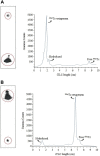Radiosynthesis, quality control, biodistribution, and infection-imaging study of a new 99mTc-labeled ertapenem radiopharmaceutical
- PMID: 36426099
- PMCID: PMC9680013
- DOI: 10.3389/fchem.2022.1020387
Radiosynthesis, quality control, biodistribution, and infection-imaging study of a new 99mTc-labeled ertapenem radiopharmaceutical
Abstract
Ertapenem is a member of carbapenem antibiotics used for the treatment of moderate-to-severe intra-abdominal, urinary tract, acute pelvic, and post-surgical gynecologic infections. The antibacterial activity of ertapenem is mediated through binding to penicillin-binding proteins which results in inhibiting the cross-linking of the peptidoglycan layer of the bacterial cell wall. Therefore, ertapenem can be labeled with technetium-99m (99mTc), a gamma emitter radionuclide, for the diagnosis of deep-seated bacterial infections, such as urinary tract, intra-abdominal, osteomyelitis, and post-surgical gynecologic infections. The labeling procedure was carried out by varying the reaction conditions, such as the amount of the ligand and reducing agent, pH, reaction time and temperature, and radioactivity. At optimized reaction conditions more than 93% 99mTc-ertapenem radioconjugate was obtained. 99mTc-ertapenem was found 90% intact in saline medium up to 6 h, while 88% intact in human blood serum up to 3 h. Biodistribution study showed target-to-non-target ratios of 2.91 ± 0.19, 2.39 ± 0.31, and 1.23 ± 0.22 in S. aureus, E. coli, and turpentine oil-infected rat models, respectively. The SPECT scintigraphy showed high uptake of 99mTc-ertapenem in bacterial-infected abscesses, and low counts were recorded in normal and turpentine oil-inflamed tissues. In conclusion, 99mTc-ertapenem can be a potent infection-imaging agent, which can diagnosis deep-seated bacterial infections at early stage but need further pre-clinical evaluation in variety of infection models.
Keywords: SPECT imaging; ertapenem; infection imaging; metal complex; nuclear medicine; radiopharmaceuticals.
Copyright © 2022 Naqvi, Jabbar, Alharbi, Noureen, Alharbi, Sherazi, Shahzadi, Ahmed, Afzal and Imran.
Conflict of interest statement
The authors declare that the research was conducted in the absence of any commercial or financial relationships that could be construed as a potential conflict of interest.
Figures







References
-
- Akhtar M. S., Iqbal J., Khan M. A., Irfanullah J., Jehangir M., Khan B., et al. (2004). 99mTc-labeled antimicrobial peptide ubiquicidin (29-41) accumulates less in Escherichia coli infection than in Staphlococcus aureus infection. J. Nucl. Med 45, 849–856. - PubMed
-
- Bader J. C., Lakota E. A., Dale G. E., Sader H. S., Rex J. H., Ambrose P. G., et al. (2019). Pharmacokinetic-pharmacodynamic evaluation of ertapenem for patients with hospital-acquired or ventilator-associated bacterial pneumonia. Antimicrob. Agents Chemother 63, e00318-e00319. 10.1128/aac.00318-19 - DOI - PMC - PubMed
-
- Drevensek P., Zupancic T., Pihlar B., Jerala R., Kolitsch U., Plaper A., et al. (2005). Mixed-valence Cu(II)/Cu(I) complex of quinolone ciprofloxacin isolated by a hydrothermal reaction in the presence of L-histidine: Comparison of biological activities of various copper-ciprofloxacin compounds. J. Inorg. Biochem 99, 432–442. 10.1016/j.jinorgbio.2004.10.018 - DOI - PubMed
LinkOut - more resources
Full Text Sources

